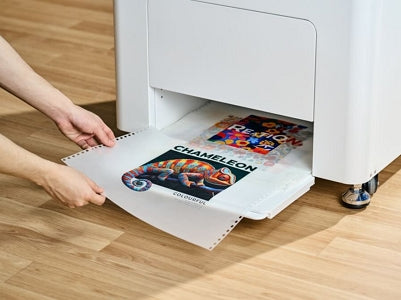How to Sublimate A Shirt?
If you need a t-shirt where the design doesn’t sit on the surface but becomes one with the fabric. A print that stands the test of time and resists fading after countless washes. Sublimation is the way to go. But how do you do it?
This blog post will walk you through the t-shirt sublimation process in simple steps. We’ll start with the tools and then move on to the actual process.
In This Article
- What Are Sublimation Shirts?
- Tools and Supplies Needed to Make Sublimation Shirts
- Step-by-Step Sublimation Process for Shirts
- Tips for Successful Sublimation T-shirt Printing
- FAQs of Sublimation T-shirt Printing
What Are Sublimation Shirts?
Seen those light-colored shirts with vibrant designs, realistic photos, or cool all-over patterns? That’s probably sublimation at work.
Sublimation printing is a digital printing technique based on the science of ‘sublimation.’ Here’s how it works: a special dye is printed onto coated paper using a sublimation printer. Then, with the help of a heat press, the design is transferred onto the shirt. The heat causes the ink to vaporize and bond with the fabric, becoming a permanent part of it.
But here’s the thing—sublimation only works on certain fabrics, specifically light-colored synthetic ones like polyester. Why? Because polyester has a special structure at the molecular level. When heated, the polyester fibers open up and let the vaporized dye seep in and become locked in as the fabric cools down. This process creates vivid, long-lasting designs.
Now, if you’re thinking about cotton shirts, sublimation won’t work directly. But there’s a workaround: you can use polymer coating spray or add a vinyl layer to the cotton first, then heat transfer your design.
Tools and Supplies Needed to Make Sublimation Shirts
Got the process? Still, interested in moving forward? Gather these tools first:
Polyester T-Shirt
Choose a plain, light-colored polyester t-shirt or a polyester blend. If choosing a blend, make sure it’s at least 65% polyester.
Sublimation Ink
Sublimation printing requires a special dye that turns into gas when heated, bonding with the polyester fibers. Like regular inks, it is also available in four CMYK colors and comes in cartridges or bottles for easy insertion into your printer.
Sublimation Printer
Unlike regular inkjet printers, a sublimation printer uses a specialized injection technology utilizing micro piezo heads – they are capable of handling any pigment or dye-based inks. Epson and Saw Grass make some great sublimation printers.
Sublimation Paper
Sublimation transfer paper has a special coating that holds the ink and releases it onto the fabric during the heat press process. For light-colored shirts, standard sublimation paper works well. For other shirts, you may need special transfer paper designed to work with darker fabrics.
Heat Press
The heat press is the key to a successful sublimation process as it provides the precise pressure and heat needed to transfer your design onto the fabric. There are various types available, from flat presses to specialized mug presses.
For shirts, a flat press is needed. The xTool Heat Press stands out in this category. Unlike bulkier models, it offers two convenient sizes: smart and mini. The smart version is perfect for larger sublimation prints and can be used hands-free or with a clamp setup. The mini-press is ideal for small designs. Both are lightweight, portable, and easy to use for all types of heat transfer printing – be it HTV, DTF, or sublimation.

XTOOL HEAT PRESS
Heat Press for Sublimation, HTV, and DTF Transfers
Flexible heat press modes - portable or hands-free for most transfer needs.
Learn MoreOther Small Accessories
- Heat Resistant Tape: to secure the transfer paper in place on the shirt.
- Scissors: for cutting the design on the transfer paper.
- Lint Roller: Remove any dust or lint from the shirt before pressing.
- Silicone Paper: Protect the shirt and heat press from any ink bleed during the process.
Step-by-Step Sublimation Process for Shirts
With all the tools and supplies secured, let’s move to the t-shirt sublimation process.
Step 1: Preparing the Design

©Mr.CraftyPants – YouTube
You can create your design using specialized graphic design software like Adobe Photoshop, and Illustrator, or free tools like Canva. When designing, ensure your image is high-resolution (at least 300 DPI) to avoid pixelation.
Remember to mirror your image before printing, especially if it contains text so that it appears correctly on the shirt.

If you’re downloading the design from a site, do check the copyright laws. Some designs are free for personal use but not commercially. For the best designs, you can try out Etsy or Design Bundles.
Step 2: Printing the Sublimation Transfer Paper
After finalizing the design, counter-check it with your shirt’s size. Make sure it’s neither too small or big for the shirt.
Print it onto the sublimation transfer paper using your sublimation printer.

Ensure that you use sublimation ink and that your printer settings are adjusted for the type of transfer paper. Ideally, a slow speed and the highest quality settings are recommended.
After printing, let the paper dry completely to avoid smudging. You may cut out the design around the edges if the ink marks have spread over the paper.

Step 3: Preparing the Shirt
Prepare your shirt by placing it on a flat, clean surface. With a lint roller, remove any dust or lint that could interfere with the sublimation process.
Pre-press the shirt using your heat press machine for 10 seconds to eliminate moisture and wrinkles.
Step 4: Applying the Transfer

Position the sublimation transfer paper face down onto the shirt where you want the design to appear. Use heat-resistant tape to secure the paper in place.
Cover the shirt and transfer paper with a protective sheet or silicone paper to prevent any ink from transferring onto the heat press.
Press the shirt using your heat press machine. The temperature should be set between 375 to 400°F (204°C), and the pressing time needs to be between 40 to 60 seconds.
After pressing, carefully remove the protective sheet and transfer the paper from the shirt. Be cautious, as the paper and shirt will be hot.
Allow the shirt to cool before handling it further. The design is now permanently embedded into the fabric. Avoid washing it before 24 hours.


XTOOL HEAT PRESS
Heat Press for Sublimation, HTV, and DTF Transfers
Flexible heat press modes - portable or hands-free for most transfer needs.
Learn MoreTips for Successful Sublimation T-shirt Printing
For a successful sublimation on shirts, remember these few key points:
- Apply heat-resistant tape to secure the design and prevent ghosting—where the design shifts slightly during pressing, causing a blurry, double image.
- Pre-press the shirt for 5 to 10 seconds with light pressure to remove wrinkles or moisture.
- Run a lint roller over the shirt’s surface to remove dust and lint. If you sublimate over lint, the ink will bond to the fibers instead of the fabric, affecting the final result.
- If there’s any excess ink around the design, carefully trim the edges. Unwanted ink can transfer during pressing and ruin the final look.
FAQs of Sublimation T-shirt Printing
What Shirts Can You Sublimate On?
Sublimation works best on 100% polyester shirts or those with at least 65% polyester. The higher the polyester content, the better the results will be.
Can You Sublimate on Cotton Shirts?
You can’t sublimate directly on cotton, but it’s possible by using a polyester coating spray. This allows the dye to bond with the shirt’s surface.
Can You Sublimate on Dark Shirts?
Sublimation on dark shirts requires specialized dark transfer paper. Another option is to pre-press HTV (heat transfer vinyl) onto the shirt and then sublimate over it.





